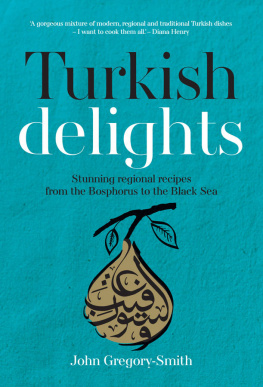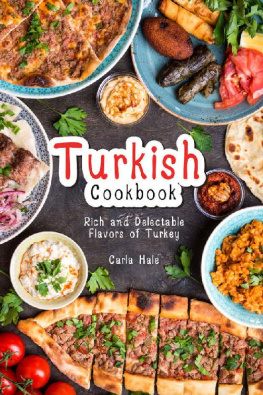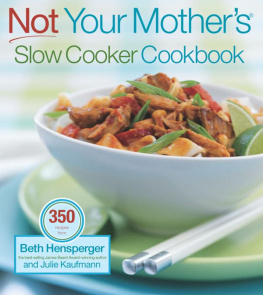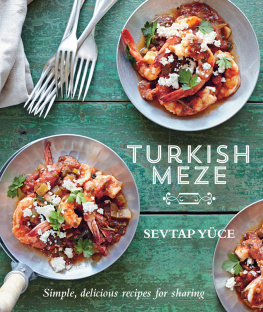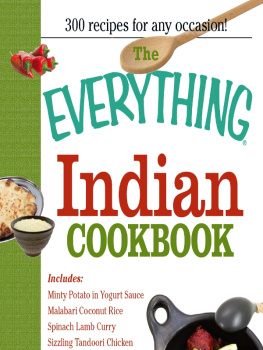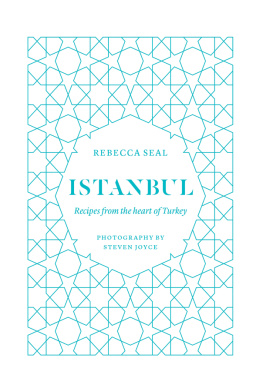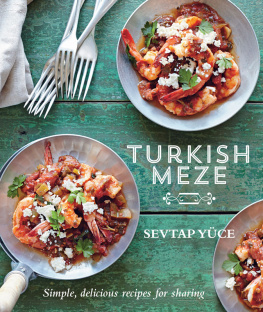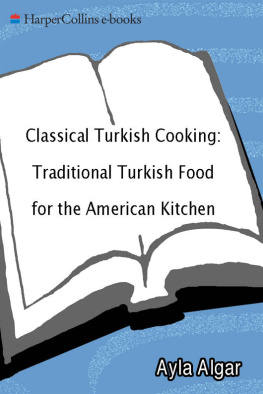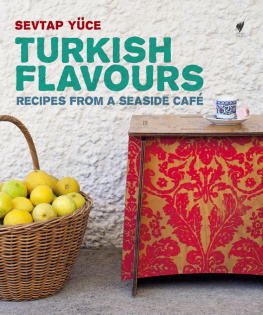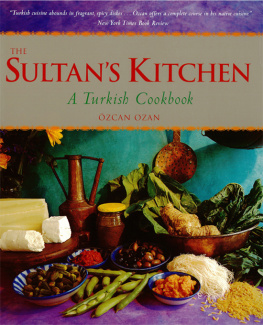Special heartfelt thanks go to my editor, Isabelle Bleecker, and to the entire staff at Periplus Editions; thanks to Cari Tremblay, an astonishing photographer and his fine crew, Jill Winitzer for her beautiful book design, and George Simons for his special touch with food. A warm thank you to Nancy Anthony, who helped me through all the stages of the book and, finally, thanks to my fine kitchen staff.
The publisher would like to thank the many people and shops for items that appear in the photographs: Alianza Contemporary Crafts, Boston, and artist Eileen Jager; Bean's gallery, Brookline, Massachusetts, and artist Kay Young; Country Floors, Inc. for ceramic tiles; Crate & Barrel; artist Alev Denis for her handcrafted plates from Shake the Tree Gallery, Brookline, Massachusetts, and her beautiful mosaics; The Denby Pottery Company of Freeport, Maine; Kitchen Arts, Boston; Maxwell's Pottery Outlet, of Freeport, Maine; Mohr & McPherson, Cambridge, Massachusetts; Newbury Imports, Boston; Pottery Barn; La Ruche, Boston; The Society of Arts and Crafts, Boston, and artists Karen Futral and Joe Spoon; Stone's Throw Gallery, Brookline, Massachusetts, and artists Janet Albert and Lynn Latimer; and especially Mari Quirk of Associated Quirks, for her beautiful backgrounds and surfaces.
The publisher would also like to thank the following people for their gracious assistance in the preparation of this book: Madeleine Bleecker, Maggie Carr, Andrea Chesman, lea Cohen, Jill Feron, Kim Frazee, Beth Ann Gerstein, Jessica Gallagher at Crate & Barrel, Kim Grogan, Paula Kesseli, Katie King, Marion Klausner, Steve Lamont, Janet McHugh, Deane Norton, Cecil and Arline Ross, Kathryn Sky-Peck, Edana Spieker, David Vanluven, Pat VanWagoner, 'Roberta and AI Winitzer.
MEZE APPETIZERS
~~~~~~~~~~

TURKISH CUISINE IS PERHAPS BEST known for its seemingly endless variety of hot and cold dishes that make up a meze. A meze (literally, "table") can be-and often is-served as an entire meal. It changes with the seasons and localeaccording to what foods are available-but is constant in its abundance of choices. Fish restaurants along the coast serve specialty meze consisting of an array of seafood dishes prepared with squid, shrimp, octopus, mussels, or that most enticing of dishes-resh sardines wrapped in grape leaves, which are eaten in late summer.
Seasonal vegetables are cooked in olive oil and flavored with herbs, a method called zeytinyal Dolmalar (dolmas) are vegetables like peppers, artichokes, and eggplants, that are stuffed with rice, pine nuts, currants, and even meat. leafy vegetables like grape leaves that are rolled around the stuffing are called sarmalar (sarmas). (Many people mistakenly call stuffed grape leaves dolmas). Vegetable dishes in a meze are invariably served with Sarmsakl Yogurt Sos, a tangy yogurt-garlic sauce (page ).
Eggplant, perhaps the most used vegetable in Turkish cuisine, is prepared in a number of ways for meze. Small eggplants stuffed with onion, garlic, tomato, and parsley make up the classic Imam Bayld. In Pathcan Salatas, char-grilled eggplant is cut into pieces and mixed with tomatoes and grilled peppers. Pathcan Ezmesi is a pureed eggplant dish-ezmesi means "pureed." Tomatoes, spinach, chickpeas, dried fava beans, and fava beans are also prepared this way.
A meze always includes sliced soft white cheese ( beyaz peynir, which is like feta cheese), peeled and sliced ripe tomatoes, cucumbers, pistachios, fresh almonds, melons (when in season), and olives that are drizzled with olive oil and lemon juice and sprinkled with herbs. Fresh-baked bread is placed on the table, too. These dishes are traditionally enjoyed with the popular Turkish drink rakior "lion's milk" as it is often called-an anise-flavored liqueur that turns white when it is mixed with water.
What makes a meze such a good way to feed guests is that most of the food can be prepared a day in advance. Though a simple meze consists of as few as three dishes, for special occasions a selection of four or five vegetable dishes cooked in oil and stuffed vegetable dishes is arranged on the table alongside breks, freshly baked bread, and tasty salads. Sometimes char-grilled fish or meat is also served.


~ Swooning Imam
~~~~~~~~~
Acl Domates Ezmesi
Spicy Pureed Tomatoes
SERVES 4-6
This specialty of eastern Turkey is deep red and has a warm, rich flavor. If you do not find the color red enough, add a bit of tomato paste. Serve it with grilled meat, chicken or fish.
4 large tomatoes, peeled, seeded and finely chopped (2 1/2 cups)
3 scallions, trimmed and finely chopped, some green parts included
1 large cucumber, peeled, seeded, and finely chopped (1 cup)
2 Italian green peppers, finely diced (1/2 cup)
1 tablespoon dried mint
1/4 cup finely chopped parsley
3 tablespoons virgin olive oil
2 tablespoons lemon juice
2 tablespoons white wine vinegar
4 garlic cloves, minced
1/4 cup paprika
1 teaspoon freshly ground black pepper
3 teaspoons Turkish red pepper or ground red pepper
Salt
Pita bread
Place all the ingredients except the pita bread in a food processor fitted with a metal blade, and pulse two or three times, just long enough to make a finer consistency. Place the mixture in a shallow serving bowl, cover it and refrigerate for 1 hour. Serve chilled or at room temperature with pita bread.
~~~~~~~~~
Imam Bayld (Swooning Imam)
Stuffed Eggplant
SERVES 6
The story is that when an imam came home from the mosque, his wife had prepared this dish for his lunch. On tasting it, he fainted. Some think it was because he was so delighted with the dish; others think that his reaction was more due to the high cost of one of its main ingredients: olive oil.
6 Italian eggplants (about 2 pounds), each about 6 inches long
3/4 cup virgin olive oil, divided
4 medium Spanish onions, thinly sliced (2 cups)
12 garlic cloves, finely chopped
2 large tomatoes, peeled and chopped (1 1/2 cups)
1 bunch fresh Italian parsley, trimmed and coarsely chopped
2 teaspoons sugar
Salt and freshly ground black pepper
1 cup light olive oil or vegetable oil
3 small Italian green peppers, seeded and cut in half
Heat the oven to 350F.
Peel off half the eggplant skin on each eggplant in alternating lengthwise strips to create a striped effectbut leave the stems intact. Make a deep slit lengthwise along the center of each eggplant; do not cut all the way through or all the way to the ends. Place the eggplants in a bowl, sprinkle them generously with salt, and cover them with cold water. Let the eggplants soak for about 20 minutes.
Heat 1/2 cup of the virgin olive oil in a deep skillet over medium heat. Using a wooden spoon, stir in the onion, garlic, tomatoes, parsley, and sugar. Season with salt and pepper. Add 1/4 cup cold water and stir the mixture well. lower the heat, cover the skillet, and simmer for about 12 minutes, stirring occasionally, until the onions are softened but not brown. Uncover the skillet and let the mixture cool.
Rinse the eggplants under cold running water. Gently squeeze out the excess water and pat the eggplants dry with paper towels.


